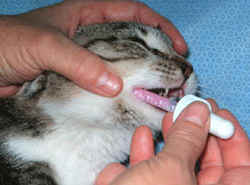How do you give oral medications to a cat?

Giving a cat oral medication isn’t always the easiest task, but by remaining calm and following the guidance below, you can make sure your pet gets the medications it needs.
Your veterinarian will tell you if your cat’s medication should be given with food or on an empty stomach. If the tablet or capsule can be given with food, you may make a “meatball” by placing the medication in the center of a small ball of canned cat food or cheese.
Cats are more likely than dogs to chew their food, so felines often eat the “meatball” and spit out the tablet or capsule. This causes the tablet or capsule to partially dissolve and become difficult to handle. If the cat bites into the tablet or capsule, it will leave a bad taste in its mouth and likely make a second attempt more difficult.
The following instructions will help you give medications if a “meatball” doesn’t work for your cat. Use caution to avoid being bitten. A cat’s mouth contains many bacteria and bites can result in deep punctures. If bitten, clean the wound thoroughly and seek medical attention.
Medications for oral administration may be in pill, capsule, or liquid form.
Giving a cat pills or capsules

Hold the cat’s head from the top using your left hand if you are right-handed. The cat’s cheekbones provide a convenient handle to hold the head firmly without causing discomfort.

Tilt the head back and the cat will often drop its lower jaw open.

Hold the pill or capsule with your right hand between your thumb and index finger. You can use a remaining finger on your right hand on the lower incisors to keep the lower jaw open. Keep your finger over the small incisor teeth and not over the sharp fangs (canine teeth). Drop the pill or capsule as far back over the tongue as possible, then immediately close the mouth and blow on the cat’s nose to encourage it to swallow.

If the cat does not open its mouth when you tilt back the head, hold the pill as before and place your middle finger of the same hand over the small incisor teeth – not over the sharp fangs (canine teeth) – to open the lower jaw.

Pull open the lower jaw. Keep your middle finger in place to hold the lower jaw open (3), then either drop the pill or capsule as far back on the tongue as possible or use your index finger (1) and thumb (2) to push the pill over the back of the tongue.

If you use your thumb and index finger to push the pill over the base of the tongue, your fingers will be inside the cat’s mouth, and you must work rapidly to avoid getting bit.
Close the mouth and stroke the cat’s neck or blow sharply on its nose to encourage swallowing.

Pilling devices can be used to place a pill or capsule over the base of the tongue, so you do not have to place your fingers in the cat’s mouth. There are several ways to hold the pilling device.


You can hold the device between your thumb and middle finger and position your index finger to “push” the trigger. To prevent premature release of the pill, you can move your index finger to push the trigger just before dislodging the pill in the back of the throat.


You can also curl your fingers around the device with your thumb positioned to “push” the trigger. To prevent premature release of the pill, you may move the thumb to push the trigger just before dislodging the pill in the back of the throat.

You can also hold the device between your index and middle fingers with your thumb positioned to “push” the trigger.

After finding a comfortable grip, tilt the cat’s head back. It will often drop its lower jaw open. Insert the pill at the end of the pilling device over the base of the tongue.

If the cat doesn’t open its mouth, use the middle finger of the hand holding the pilling device to open the lower jaw. Insert the pill at the end of the pilling device over the base of the tongue. Push the plunger on the pilling device with your thumb or index finger to deposit the pill far back in the cat’s mouth.
Giving a cat liquid medications

Liquid medications are given in a pouch between the teeth and cheek. Quickly squirt the medication into the pouch, hold the cat’s mouth closed, and stroke its neck or sharply blow on its nose to encourage swallowing.
Liquids are more likely to accidentally enter the windpipe compared to pills or capsules. To avoid the cat inhaling liquid into the windpipe, do not tilt the cat’s head backward.
If you find it difficult to give your cat a pill or capsule, speak to your veterinarian about suspending the pill or capsule into a liquid. Some medications can be suspended in liquid while others lose their effectiveness. Always talk to your veterinarian before altering medication.
This information is not meant to be a substitute for veterinary care. Always follow the instructions provided by your veterinarian.
